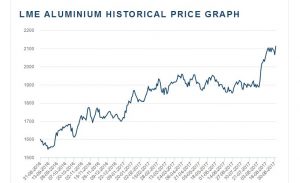 The stakeholders in the steel and aluminium markets went into a tizzy when US presi- dent Donald Trump confirmed the levy of tariff on imports of both the metals in the United States.
The stakeholders in the steel and aluminium markets went into a tizzy when US presi- dent Donald Trump confirmed the levy of tariff on imports of both the metals in the United States.
According to a report which quoted Moody’s note, said, metal sectors are in for a struggle thanks to higher prices – especially on the aluminium side. It also said how it may hurt industrial manufacturers that rely on these commodities as key raw materials in production.
The printing industry is one, and the concern is more immediate because of the printing plates. Closer home, the sudden surge in aluminium prices has resulted from the recent sanctions imposed by the US government on Russia’s largest and world’s second-largest aluminium producer Rusal. In April 2018, aluminium prices surged by 30%. Rusal’s big- gest export markets are the US and the EU, which are also the biggest aluminium deficit markets with a reported deficit of 4.7 and 3.8 million tonnes, respectively. The sanctions imposed on Rusal will take away over 6% of global supply, and 14% outside China, as per media reports.
According to the reports, average aluminium prices are expected to firm up by USD 150 per tonne globally. Beside the sanction, according to reports, input cost in aluminium is also includes. Plus, recently, around (around) two million tonnes of aluminium smelter capacity went offline in China because of pollution concerns.
On cue, major printing plate manufacturers – Agfa Graphics, Kodak, Xingraphics, Fujifilm, have all hiked their plate prices.
Agfa Graphics announced a substantial price increases of up to 10%, will be implemented imme- diately. “Soaring prices of aluminum – the largest cost component of a printing plate – are the main reason for this decision,” said Stefaan Vanhooren, president of Agfa Graphics. ”However, thanks to the increased intrinsic recycle value of the used printing plates, the price increase will not necessarily result in a cost increase for our customers.”
Kodak was not behind announcing that plate prices will increase up to 9%. John O’Grady, president, print systems division, Kodak, explained, “With aluminum prices now reaching multi-year highs, it has become necessary to institute a plates price increase. While Kodak has worked diligently to reduce its own costs to lessen the impact of aluminum, the delta has become too great for us to bear, while maintaining our brand promise as a supplier of quality plates to the industry.”
Kodak will communicate the new pricing structure to all customers and dealers across the world in due course. “Looking to the future, we are exploring different business models to reduce the effect of aluminum volatility on our customers,” O’Grady added. “There are also measures that our customers can take to offset the increase in plate prices. Printers benefit from higher aluminum prices when they recycle their used plates, and many customers are saving additional money by switching to Kodak Sonora process free plates to eliminate the costs of plate processing, including chemistry, water, and electricity costs.”
According to Xingraphics, it has been all the time working with great effort to improve internal efficiencies, and reduce the impact of rising costs; however, these effort could not offset the huge cost pressure from raw material hike recently.
Depending on the different markets and regions, Fujifilm said, the price increase of it plate will be
in the double digit region and will be implemented immediately. “The costs of various raw materials such like aluminum are significantly soaring and Fujifilm is no longer able to absorb the increased costs despite of continuous efforts to improve productivity and internal efficiencies. The price increase is necessary to maintain its production, providing quality services and research and develop- ment activities in order to support and contribute to the global printing industry,” said Fujifilm.
The price increases in essentials required for producing print, as it is in other industries, will only put pressure on the already margin pressures. It is evident that there are no winners in a trade war and the damage on print is going to be on both sides – the print community as well as the suppliers.



